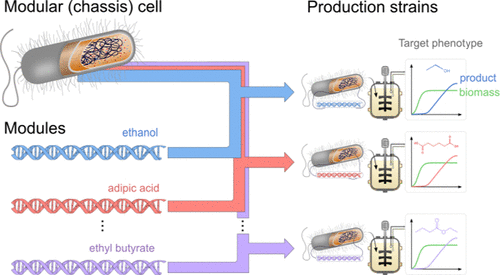当前位置:
X-MOL 学术
›
ACS Synth. Biol.
›
论文详情
Our official English website, www.x-mol.net, welcomes your
feedback! (Note: you will need to create a separate account there.)
Harnessing Natural Modularity of Metabolism with Goal Attainment Optimization to Design a Modular Chassis Cell for Production of Diverse Chemicals.
ACS Synthetic Biology ( IF 3.7 ) Pub Date : 2020-05-29 , DOI: 10.1021/acssynbio.9b00518 Sergio Garcia 1, 2 , Cong T Trinh 1, 2
ACS Synthetic Biology ( IF 3.7 ) Pub Date : 2020-05-29 , DOI: 10.1021/acssynbio.9b00518 Sergio Garcia 1, 2 , Cong T Trinh 1, 2
Affiliation

|
Modular design is key to achieve efficient and robust systems across engineering disciplines. Modular design potentially offers advantages to engineer microbial systems for biocatalysis, bioremediation, and biosensing, overcoming the slow and costly design–build–test–learn cycles in the conventional cell engineering approach. These systems consist of a modular (chassis) cell compatible with exchangeable modules that enable programmed functions such as overproduction of a desirable chemical. We previously proposed a multiobjective optimization framework coupled with metabolic flux models to design modular cells and solved it using multiobjective evolutionary algorithms. However, such approach might not achieve solution optimality and hence limits design options for experimental implementation. In this study, we developed the goal attainment formulation compatible with optimization algorithms that guarantee solution optimality. We applied goal attainment to design an Escherichia coli modular cell capable of synthesizing all molecules in a biochemically diverse library at high yields and rates with only a few genetic manipulations. To elucidate modular organization of the designed cells, we developed a flux variance clustering (FVC) method by identifying reactions with high flux variance and clustering them to identify metabolic modules. Using FVC, we identified reaction usage patterns for different modules in the modular cell, revealing that its broad pathway compatibility is enabled by the natural modularity and flexible flux capacity of endogenous core metabolism. Overall, this study not only sheds light on modularity in metabolic networks from their topology and metabolic functions but also presents a useful synthetic biology toolbox to design modular cells with broad applications.
中文翻译:

利用目标达成最佳化来利用代谢的自然模块性来设计用于生产多种化学品的模块化底盘细胞。
模块化设计是实现跨工程学科的高效,强大系统的关键。模块化设计可能为工程微生物系统的生物催化,生物修复和生物传感提供优势,克服了常规细胞工程方法中缓慢而昂贵的设计,构建,测试和学习周期。这些系统由与可交换模块兼容的模块化(底盘)电池组成,这些模块可实现已编程的功能,例如过量生产所需的化学品。我们先前提出了一个多目标优化框架,并结合了代谢通量模型来设计模块化细胞,并使用多目标进化算法对其进行了求解。但是,这种方法可能无法实现解决方案的最优性,因此限制了实验实施的设计选择。在这个研究中,我们开发了与可确保解决方案最优的优化算法兼容的目标达成公式。我们运用目标达成来设计大肠杆菌模块化细胞,仅需很少的基因操作,即可以高收率和高产率合成生物化学多样化文库中的所有分子。为了阐明所设计细胞的模块化组织,我们开发了一种通量方差聚类(FVC)方法,方法是识别具有高通量方差的反应并将其聚类以识别代谢模块。使用FVC,我们确定了模块化细胞中不同模块的反应使用方式,表明其广泛的途径相容性是由内源性核心代谢的自然模块化和灵活的通量能力实现的。总体而言,这项研究不仅从其拓扑结构和代谢功能阐明了代谢网络中的模块性,而且提出了一个有用的合成生物学工具箱,可设计具有广泛应用的模块化细胞。
更新日期:2020-07-17
中文翻译:

利用目标达成最佳化来利用代谢的自然模块性来设计用于生产多种化学品的模块化底盘细胞。
模块化设计是实现跨工程学科的高效,强大系统的关键。模块化设计可能为工程微生物系统的生物催化,生物修复和生物传感提供优势,克服了常规细胞工程方法中缓慢而昂贵的设计,构建,测试和学习周期。这些系统由与可交换模块兼容的模块化(底盘)电池组成,这些模块可实现已编程的功能,例如过量生产所需的化学品。我们先前提出了一个多目标优化框架,并结合了代谢通量模型来设计模块化细胞,并使用多目标进化算法对其进行了求解。但是,这种方法可能无法实现解决方案的最优性,因此限制了实验实施的设计选择。在这个研究中,我们开发了与可确保解决方案最优的优化算法兼容的目标达成公式。我们运用目标达成来设计大肠杆菌模块化细胞,仅需很少的基因操作,即可以高收率和高产率合成生物化学多样化文库中的所有分子。为了阐明所设计细胞的模块化组织,我们开发了一种通量方差聚类(FVC)方法,方法是识别具有高通量方差的反应并将其聚类以识别代谢模块。使用FVC,我们确定了模块化细胞中不同模块的反应使用方式,表明其广泛的途径相容性是由内源性核心代谢的自然模块化和灵活的通量能力实现的。总体而言,这项研究不仅从其拓扑结构和代谢功能阐明了代谢网络中的模块性,而且提出了一个有用的合成生物学工具箱,可设计具有广泛应用的模块化细胞。











































 京公网安备 11010802027423号
京公网安备 11010802027423号